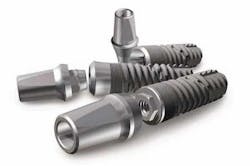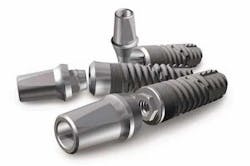Dental implants and titanium dioxide nanotubes
Dental implants posts are usually made of titanium, surgically placed into the jawbone, and topped with artificial teeth. Dental implants imitate the look and feel of natural teeth, more so than dentures or bridges. While most dental implants are successful, a small percentage fail or must be removed. A scientist at Michigan Technological University found a way to lower that rate of failure to zero using nanotechnology.
Dental implants can greatly improve the lives of people who need them but there are two chief concerns regarding their longevity. They are infection and separation of the implant from the bone, or lack of osseo integration. Bacterial infections are a risk after implant surgery, and sometimes bone fails to heal securely around the device. Because some parts of the maxilla and mandible are somewhat thin and delicate, replacing a failed implant can be difficult. Implants can be expensive and implants are seldom covered by dental insurance. This research studied a nano-material that can combat infection, improve healing, and help dental implants last longer, titanium dioxide nanotubes. A clinical assistant professor at the University of Illinois at Chicago (UIC), College of Dentistry, Cortino Sukotjo, has been working on a dental implant with a surface made from TiO2 nanotubes. The toxicity tests on the nanotubes, and that the nanotubes killed bacterial growth and also encouraged bone cell growth. The study demonstrated that bone cells grow more vigorously and adhere better to titanium coated with TiO2 nanotubes than to conventional titanium surfaces.(1)
(2) The nanotubes can also serve as a drug delivery system. Shokuhfar's team, in collaboration with Alexander Yarin, a professor in UIC's Department of Mechanical and Industrial Engineering, loaded TiO2 nanotubes with the anti-inflammatory drug sodium naproxen and demonstrated that it could be released gradually after implant surgery. This mechanism assures that the medication can flow to where it is needed, and it reduces the chances of possible unpleasant side effects that arise when a drug is injected or taken orally.(2)
To fight infection, the TiO2 nanotubes can also be laced with silver nanoparticles. Shokuhfar and Craig Friedrich, who holds the Richard and Bonnie Robbins Chair of Sustainable Design and Manufacturing at Michigan Tech, are conducting research, as yet unpublished, which is focused on orthopedic implants, such as artificial hips, but which also applies to dental implants.(3) According to the authors, silver has antimicrobial properties, and they were able to obtain a dose that can kill microbes, but not damage healthy cells and tissues. Specially, it can help prevent biofilms, the enormous colonies of bacteria that can cover implants and be very difficult to eliminate. A nanotextured implant surface embedded with silver nanoparticles could prevent infection for the life of the implant. The TiO2 nanotubes also have a cosmetic advantage: transparency. That is positive for any dental implant, but especially for a new type made from zirconia, which some patients choose because it is totally white. Shokuhfar and Friedrich have received a provisional patent and are working with two hospitals to further develop the technology,and eventually license it. Shokuhfar expects that implants with the new nanotubular surface will be easily assimilated into the market, since titanium implants, both dental and orthopedic, have a long history. Implants covered with TiO2 nanotubes would appear the same as conventional implants, and a clinician would follow the same implant placement procedure. For Shokuhfar, the nanotextured surface is a perfect example of small things having a big impact. The surface would be inexpensive and easy to make and will be able to improve healing and make the healing process faster. It could potentially battle infection by adding antimicrobial silver and reduce inflammation by adding sodium naproxen. It is likely that it could promote healing doubly by incorporating a growth factor into the TiO2 nanotubes.References 1. Michigan Technological University (2013, September 23). Smile! New nanotube surface promises dental implants that heal faster and fight infection. Science Daily. Retrieved September 25, 2013. 2. Tolou Shokuhfar, Suman Sinha-Ray, Cortino Sukotjo, Alexander L. Yarin. Intercalation of anti-inflammatory drug molecules within TiO2 nanotubes. RSC Advances, 2013; 3 (38): 17380 -17386. DOI: 10.1039/C3RA42173B. 3. T. Shokuhfar, J.Y. Chang, C.K. Choi, C. Friedrich. Biophysical Evaluation of Osteoblasts on TiO2 Nanotubes. Nanomedicine: Nanotechnology, Biology, and Medicine, Dec 2011, Under Revision. The paper, "Survivability of TiO2 Nanotubes on the Surface of Bone Screws," has been accepted by the journal, Surface Innovations. It describes work showing that specially treated TiO2 nanotubes on the surface of orthopedic bone screws survive insertion and removal in bone simulant material.




